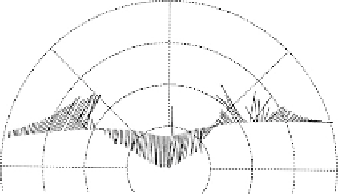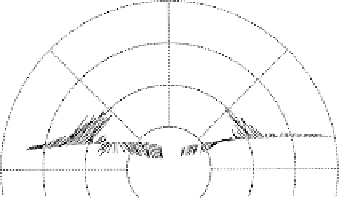Geoscience Reference
In-Depth Information
DE - B Ion drift velocities
MLT v ILAT
B
x
51
Northern Hemisphere
3.0
B
y
52
1.0
B
z
521.3
12
15
9
18
6
B
x
51
3.0
B
y
524.0
B
z
52
12
2.0
15
9
6
18
1 km/sec
(c)
Figure 8.8c
The plasma drift velocity perpendicular to the magnetic field measured dur-
ing two satellite passes through the high-latitude ionosphere is represented here by drift
velocity vectors.
of an organized convection pattern is possible, it is characterized surprisingly by a
sunward flow component (a dusk-to-dawn electric field) in the central polar cap.
In addition, the entire region of significant plasma motion is confined to much
higher latitudes than in the southward IMF case. Figure 8.11 shows several
examples of the dawn-to-dusk electric field measured at high latitudes when
the IMF had a northward component. The shaded regions show the existence
of a dusk-to-dawn field and thus sunward flow deep in the polar cap. Quite
frequently, the flow is extremely structured at small scales, and observations
can look more typically like those shown in Fig. 8.12a. Despite the difficulties
associated with the recognition of convection features during northward IMF,
a qualitative description is possible, as summarized in Fig. 8.12b. When the
IMF has a northward component, four convection cells can be identified in the
dayside hemisphere. Two high-latitude cells circulate in a manner that produces
sunward convection at the highest latitudes. The size and orientation of these
cells depend to first order on the magnitude and sign of the
y
component of the
IMF. When
B
y
is very small, these two cells are located approximately on either



Search WWH ::

Custom Search